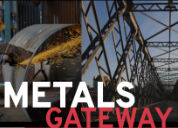Back | Latest news overview
New Metals Gateway provides ‘one stop shop’ for regulators
18/11/2020

The new Metals Gateway online portal brings together a wealth of information to provide regulators and risk assessment professionals with the metals risk assessment tools they need to help protect people's wellbeing.
The Metals Gateway package includes:
- Metals in the Environment – factsheets on what makes metals different from other chemicals, how they interact with other substances and biological organisms under different conditions, water quality, pH etc.
- REACH Metals Gateway – Guidance for the EU and International Metals Industry in the implementation process of the EU REACH and CLP Regulations. The REACH Metals Gateway allows quick and structured access to relevant information from authorities and from the metals industry.
- The Metals Toolbox - Tools and guidelines to enable regulators and stakeholders to accommodate metal-specificities in hazard identification and risk assessments.
Developed by a group of metal commodity associations including IMOA and led by Eurometaux, this free and open knowledge platform provides easy access to science-based models, data, literature, factsheets and information that are essential for understanding why the risk from metals exposures are different from other substances.
"Protection of the health and safety of consumers, workers, communities and the environment is a prerequisite of equitable and productive societies", said Violaine Verougstraete, Chemicals Management Director, Eurometaux. "Every individual and institution has a role to play in ensuring the wellbeing of all. This objective is enshrined in the UN Sustainable Development Goals and is particularly apposite as the world responds to the largest public health crisis in modern history."
"The metals sector understands the pressures and challenges that regulators are under with respect to chemicals and has worked with regulatory authorities to generate metal, metal compound and metal-containing material-specific hazard and risk assessment data for over two decades, investing many millions of dollars in basic and applied science."
"Metals and inorganic substances behave differently from other substances in the environment, in the bodies of humans and animals and in combination with each other and other chemicals," added Violaine Verougstraete. "The metals sector recognises that such differences are not necessarily well understood by all and nor are the data and tools required to assess metals and metal substance risks readily available. This is why we have developed the Metals Gateway, as a 'one stop shop' for those charged with regulation and risk assessment of metals."
Notes:
For more information, please contact Violaine Verougstraete.
The Metals Gateway is a joint initiative of the Cobalt Institute, Eurometaux, European Copper Institute, International Molybdenum Association, International Lead Association, International Zinc Association, Nickel Institute, World Aluminium.
General information for media
IMOA is a non profit trade association, representing the majority of the molybdenum industry worldwide. It works to raise awareness about the unique properties of molybdenum, its beneficial effects on materials performance, its safety in use and its contribution to sustainable development.
Molybdenum is added to alloy steels to improve strength, toughness, hardenability and weldability for numerous applications in the automotive, shipbuilding, construction, mining, chemical, oil & gas and energy generation industries. In stainless steels and superalloys, it improves corrosion resistance and high-temperature performance and finds uses in many industrial applications. It is also used in a variety of products from catalysts and lubricants to pigments and paint.
IMOA has a strict antitrust compliance policy which delegates of all meetings are required to observe. All such meetings are observed by legal counsel.
For more information please email the communications team at media@imoa.info.
For up-to-date information please follow IMOA on Twitter and LinkedIn.
Back | Latest news overview

